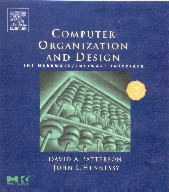 |
| (Textbook. Click for information.) |
Computer Organization II
Fall 2004
Recitation 11
Pipelining: Stalls with lw
Week 11: Nov 1-5
Due (on time): 2004-11-10 23:59:59
Due (late): 2004-11-14 23:59:59
|
Note: Submit on actual sheets of paper
at the time given at the bottom of this recitation. Recitation 11 must be submitted following directions at: submissions on or before
|
Outline: This recitation studies how a stall is used to handle the lw instruction using the pipelined implementation of MIPS. Stalls are also needed by branches and by exceptions. You are to turn in four annotated diagrams showing cycles 3 through 6 as described in Exercise 6.24 starting on page FMP 6.14-13 on the CD. (Chapter 6, For More Practice.)
The location of the exercise is confusing, since it starts on page FMP 6.14-13. Then the next two pages: FMP 6.14-14 and 6.14-15, contain diagrams related to the previous exercise. The diagram on the top of page FMP 6.14-16 is supposed to be a blank for the previous exercise, but by mistake it is the same as the blank for this exercise. Finally, Exercise 6.24 continues on the second half of page FMP 6.14-16. Pages FMP 6.14-17 through FMP 6.14-19 contain diagrams related to this exercise. You are to use 4 copies of the blank diagram on page FMP 6.14-16 or page FMP 6.14-20 to finish this recitation. (Your answers should be similar to the diagrams on pages FMP 6.14-17 through FMP 6.14-19.) (Wheh!)
Here is a GIF image of Figure 6.14.17 on page FMP 6.14-20, the blank page that you need for this recitation: Figure 6.14.17
In Exercise 6.24, the authors illustrate a stall and the use of the Hazard Detection Unit with the following sequence of instructions:
lw $2, 20($1) and $4, $2, $5 or $4, $4, $2 add $9, $4, $2The work of Exercise 6.24 is to do the same thing with the following very similar sequence of instructions:
lw $2, 20($1) add $4, $5, $2 sub $4, $4, $2
|
Contents of hand submission
for Recitation 11: Last Name, First Name; Course Number; Recitation Number (11).
|